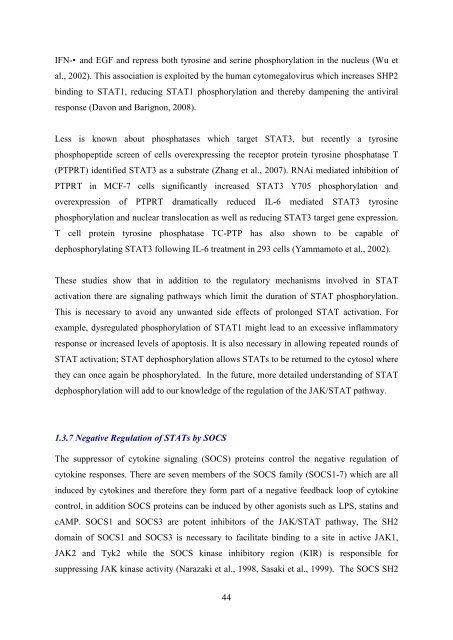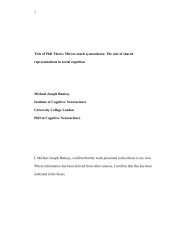Investigating the role of the JAK/STAT and MAPK ... - UCL Discovery
Investigating the role of the JAK/STAT and MAPK ... - UCL Discovery
Investigating the role of the JAK/STAT and MAPK ... - UCL Discovery
Create successful ePaper yourself
Turn your PDF publications into a flip-book with our unique Google optimized e-Paper software.
IFN- <strong>and</strong> EGF <strong>and</strong> repress both tyrosine <strong>and</strong> serine phosphorylation in <strong>the</strong> nucleus (Wu et<br />
al., 2002). This association is exploited by <strong>the</strong> human cytomegalovirus which increases SHP2<br />
binding to <strong>STAT</strong>1, reducing <strong>STAT</strong>1 phosphorylation <strong>and</strong> <strong>the</strong>reby dampening <strong>the</strong> antiviral<br />
response (Davon <strong>and</strong> Barignon, 2008).<br />
Less is known about phosphatases which target <strong>STAT</strong>3, but recently a tyrosine<br />
phosphopeptide screen <strong>of</strong> cells overexpressing <strong>the</strong> receptor protein tyrosine phosphatase T<br />
(PTPRT) identified <strong>STAT</strong>3 as a substrate (Zhang et al., 2007). RNAi mediated inhibition <strong>of</strong><br />
PTPRT in MCF-7 cells significantly increased <strong>STAT</strong>3 Y705 phosphorylation <strong>and</strong><br />
overexpression <strong>of</strong> PTPRT dramatically reduced IL-6 mediated <strong>STAT</strong>3 tyrosine<br />
phosphorylation <strong>and</strong> nuclear translocation as well as reducing <strong>STAT</strong>3 target gene expression.<br />
T cell protein tyrosine phosphatase TC-PTP has also shown to be capable <strong>of</strong><br />
dephosphorylating <strong>STAT</strong>3 following IL-6 treatment in 293 cells (Yammamoto et al., 2002).<br />
These studies show that in addition to <strong>the</strong> regulatory mechanisms involved in <strong>STAT</strong><br />
activation <strong>the</strong>re are signaling pathways which limit <strong>the</strong> duration <strong>of</strong> <strong>STAT</strong> phosphorylation.<br />
This is necessary to avoid any unwanted side effects <strong>of</strong> prolonged <strong>STAT</strong> activation. For<br />
example, dysregulated phosphorylation <strong>of</strong> <strong>STAT</strong>1 might lead to an excessive inflammatory<br />
response or increased levels <strong>of</strong> apoptosis. It is also necessary in allowing repeated rounds <strong>of</strong><br />
<strong>STAT</strong> activation; <strong>STAT</strong> dephosphorylation allows <strong>STAT</strong>s to be returned to <strong>the</strong> cytosol where<br />
<strong>the</strong>y can once again be phosphorylated. In <strong>the</strong> future, more detailed underst<strong>and</strong>ing <strong>of</strong> <strong>STAT</strong><br />
dephosphorylation will add to our knowledge <strong>of</strong> <strong>the</strong> regulation <strong>of</strong> <strong>the</strong> <strong>JAK</strong>/<strong>STAT</strong> pathway.<br />
1.3.7 Negative Regulation <strong>of</strong> <strong>STAT</strong>s by SOCS<br />
The suppressor <strong>of</strong> cytokine signaling (SOCS) proteins control <strong>the</strong> negative regulation <strong>of</strong><br />
cytokine responses. There are seven members <strong>of</strong> <strong>the</strong> SOCS family (SOCS1-7) which are all<br />
induced by cytokines <strong>and</strong> <strong>the</strong>refore <strong>the</strong>y form part <strong>of</strong> a negative feedback loop <strong>of</strong> cytokine<br />
control, in addition SOCS proteins can be induced by o<strong>the</strong>r agonists such as LPS, statins <strong>and</strong><br />
cAMP. SOCS1 <strong>and</strong> SOCS3 are potent inhibitors <strong>of</strong> <strong>the</strong> <strong>JAK</strong>/<strong>STAT</strong> pathway, The SH2<br />
domain <strong>of</strong> SOCS1 <strong>and</strong> SOCS3 is necessary to facilitate binding to a site in active <strong>JAK</strong>1,<br />
<strong>JAK</strong>2 <strong>and</strong> Tyk2 while <strong>the</strong> SOCS kinase inhibitory region (KIR) is responsible for<br />
suppressing <strong>JAK</strong> kinase activity (Narazaki et al., 1998, Sasaki et al., 1999). The SOCS SH2<br />
44
















